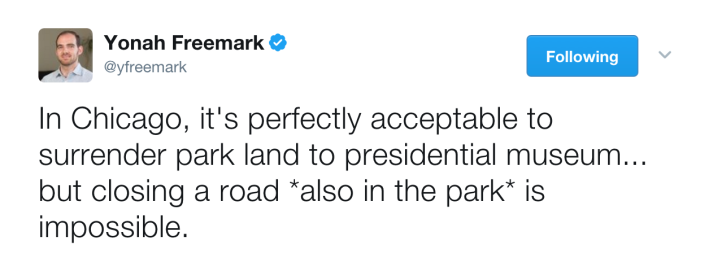At the unveiling of the designs for the Obama Presidential Center in Jackson Park earlier this month, Barack Obama explained why it makes sense to pedestrianize six-lane Cornell Drive, which currently slices through the historic green space. In addition to the lantern-shaped presidential library, the center will feature plenty of open space for picnics and other forms of recreation, including a new sledding hill.
“You can’t have little kids playing right next to the road,” Obama said. He added that it’s important not to get so “fixated on traffic that we lose sight of what’s possible.”
It’s too bad the authors of this morning’s Chicago Tribune editorial apparently missed the part about not obsessing about moving cars as quickly as possible. In fairness, the paper acknowledged that the plan for the center has many appealing aspects, and should give an economic boost to nearby neighborhoods.
But the Tribune argues that the 19,300 average daily vehicle trips on the section of Cornell that would be made car-free, between 59th and 67th, represents a “snag” in the former president’s plan. “That's a lot of traffic that needs to be accommodated, without unduly disrupting the lives and routines of South Siders,” the op-ed states. “Shutting down a heavily used road without creating a palatable alternative is no way to treat your neighbors.”
It’s certainly true that urban planning decisions in this city have historically been imposed on lower-income neighborhoods and communities of color without sufficient input from the residents. Cornell Drive itself, which blights one of the South Side’s most beautiful green spaces and was expanded to its current highway status in 1965, during the height of the Urban Renewal era, represents a textbook example of that phenomenon. As such, it will be important for residents of the largely African-American neighborhoods near the park to have a say in the plan.
But the Trib’s assumption that all of the car trips that currently take place on Cornell need to be “accommodated” is flawed.
First, let’s note that Cornell is currently way too wide for the amount of motor vehicles it carries – it has the same number of lanes as nearby Lake Shore Drive, but only a fraction of the traffic. Studies show that roads with one lane in each direction, plus turn lanes can usually handle up to 20,000 vehicles a day without creating undue congestion, so Cornell has roughly twice as wide as it needs to be for its current traffic load. Diverting some of that traffic to Stony Island Avenue and the Drive, which roughly parallel Cornell and also have excess lane capacity, is not going to create carmaggedon.

And it’s far from certain that all 19,300 of those trips will have to be accommodated in the future. Sure, there’s the possibility that more people than ever will drive to this part of town after the presidential center is built – if our urban planning decisions encourage that travel choice. If we leave Cornell intact, more car trips, congestion, and pollution are sure to result as visitors flock to the new attraction.
But there’s also the phenomenon of traffic evaporation. When driving becomes a little less convenient, people choose to use different travel modes, or opt not to make unnecessary car trips. That’s why, despite gloomy predictions from the media, the Loop never grinds to a halt when multiple downtown streets are closed for construction projects. Instead, more people choose to leave their cars at home.
That’s what will happen if driving to and past Jackson Park becomes a somewhat less attractive option. We can further encourage positive travel choices by beefing up transit, pedestrian, and bike access to the Obama center. For example this would be a golden opportunity to implement rapid transit-style service on the Metra Electric commuter line, which has stops a stone’s throw from the library site, something South Siders have been advocating for for years.
Obama noted during his speech this month that city and state transportation officials say that banishing cars from Cornell would only add one-to-three minutes to local car commutes if steps are taken to mitigate traffic impacts.
To their credit, the Tribune acknowledges that having a traffic sewer running through the middle of the park detracts from the safety and convenience of the green space, and runs completely counter to landscape architect Frederick Law Olmstead’s original vision.
But now that it's there, its utility cannot be ignored… Are there other fixes that minimize the impact of closing Cornell Drive? Would it help to widen Stony Island Avenue, which runs along the western edge of Jackson Park? Could Cornell be moved underground?
It should be obvious that destroying green space or knocking down buildings to broaden Stony, which already has six lanes near 67th, or spending billions to submerge Cornell, are terrible ideas.
“It's up to Obama and his team, in collaboration with state and local officials, to find an answer better than This'll just take you an extra minute or three,” the paper concludes. Sure, the library planners, the city and state transportation departments, the CTA, Metra, and the nearby communities should all work together to create an appropriate transportation plan for the presidential center. But the Tribune is way off base to assume that this requires accommodating as many – or more – car trips than currently exist on Cornell.





